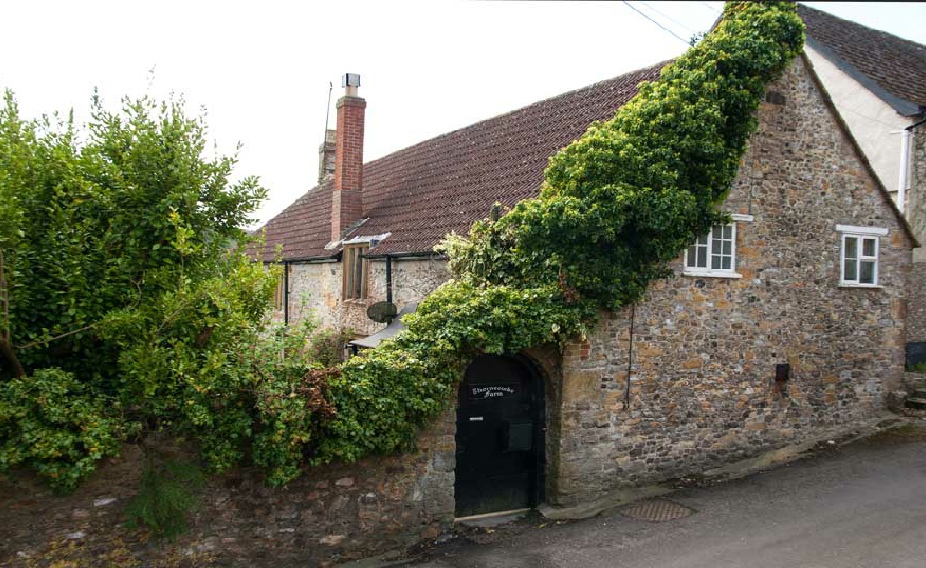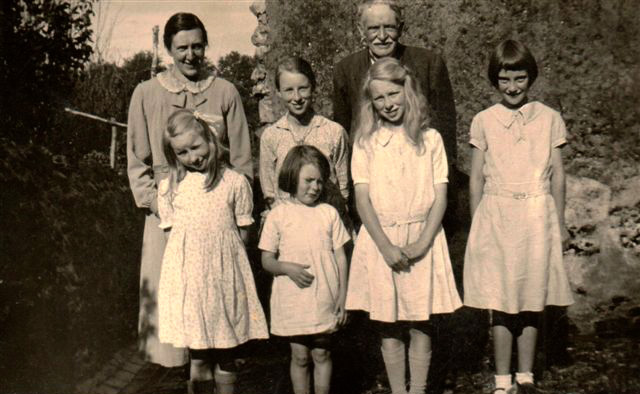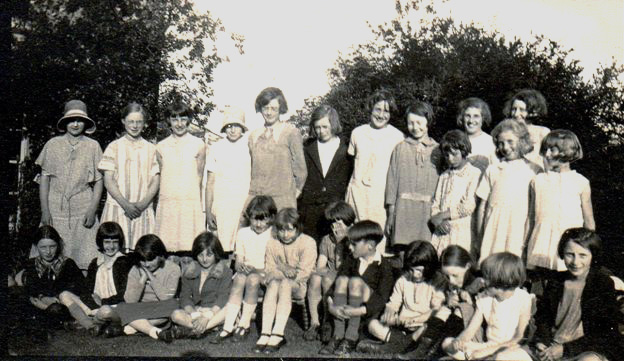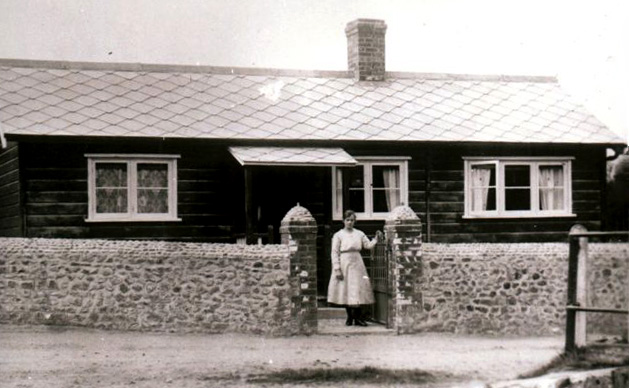



THORNCOMBE BETWEEN THE WARS

Back row right to left: Mr Ousley (who owned Thomas’s Place & The Terrace on High Street)
his daughter Elsie Ousely and Rosie Hellier (middle)
Front row left to right: Amy, Ruth and Joyce Hellier, and Vera Mann. Circa 1930.
Reproduced courtesy of Pam Wills née Mann
Mum & Dad moved to Thorncombe to start their married life at Saddle Street Farm. It is on the right hand side and is now a private house. The Miss Jones lived in a beautiful house almost opposite [Upperfold]. They had one servant [May Down]. At Christmas time, the two sisters used to invite all the children of the village to tea. Boys one week; girls the next; afterwards one sister would play the piano and the other would teach us a dance. Again in the summer we were all invited. Then we used to play croquet on the lawn and in the orchard at the back of the house where there was a swing and seesaw.
Gribb Farm
My first three sisters were born in Saddle Street, then Dad [Arthur Hellier] & Mum moved halfway up the hill above Stonelake, to Gribb Farm which Dad rented. It belonged to the vicarage. The cow stalls were up two fields. He had to carry the milk down to the dairy which was part of the house in two buckets with a yoke across his shoulders. That now has been a private house for a number of years [Glebe Cottage]. A school teacher called Miss Lucky (Miss Lukey..ed) lived there for a long time. My other sisters Alice, Rose, me, Amy, and Ruby were born there. We went to school until the age of 14. It was only in the last three years that if you were clever enough you could go to a Grammar School at I think it was Axminster. Miss Birket was Head Mistress. She was a dreadful person. But I was very fond of Wilfred Potter. He became my confessor.

Thorncombe School outing, circa 1925. Back row far left: Miss Birket, Head Mistress
Front row: left to right: Maisey Bates, Rosie Hellier, Vera Mann, Pansy Hook, May Down.
Reproduced courtesy Amy Sweet née Hellier.
Mum had a girl living in to help with all us children. Mrs Bonfield was the first and she married from there. When married the Bonfields lived in a little wooden bungalow at Stonelake. Mr Bonfield had a little Garage on the side and used to repair all the bicycles etc.

Edith Bonfield at her front gate
Reproduced courtesy of Mr P Smith.
Her husband also worked for his uncle at the post office [Bonfield’s Stores] delivering
coal around the district. Mr Bonfield’s shop was lovely. Every Christmas he had
a large Father Christmas in the window. His shelves were always full of the most
lovely sweets. There was only one phone in the village and that was in the corner
of the post office. You had to pay Mr Bonfield 6d to use it. There were three pubs
in the village, The Crown at the bottom of the hill, the Royal Oak opposite the Post
Office and one at the top of the village [T he Golden Lion].
he Golden Lion].
Bonfield Stores (right) circa 1930. Note the public telephone sign. Reproduced courtesy of Mr & Mrs B Frampton
Getting about
Next to the school lived the Vincents -
Thorncombe Farm
Dad and Mum moved to Thorncombe Farm which he bought when I was three years old [in 1926]. It had a lovely entrance next to the little chapel with fields behind it. From one field Dad gave the water to the village. A tap was built next to the Jubilee Hall. All the people around used to get their water from there. We used to supply all the village with milk, eggs, veg on Saturdays. Chicken could only be afforded at Christmas. Rabbit was what people lived on during the week. We sold them at the door for sixpence. The next day we gave them 2d for the skins. A rag and bone man came once a fornight to collect them. Thorncombe Farm was lovely. A green door, with flowers growing down the front of the house and the rest of the garden laid out to veg. Two sitting rooms and one little room we had as a play room. We used to have other children in and roast chestnuts and potatoes on the fire. Other children were always allowed to stay for tea on Saturday. It had four large bedrooms. A little gate from the garden gave entrance to all the farm buildings, all kept nice. We had our own water pump in the garden.
Hard work
Most people in those days either went to church or chapel. No one except the vicar,
The Reverend Hardy and his wife went on holiday. No one could afford it. It was just
all work. During hay making and harvest the village men all came by in the evenings
after coming home from their work to help; glad of the extra money. There was no
gas or electric, everyone cooked by an oven beside the fire or on an oil stove .
For light there were oil lamps and candles. I only ever saw one plane fly over
Thorncombe. Ruby and I thought it was following us, so we ran all the way up the
hill and hid upstairs under the bed. How life has changed. Now every road is full
of cars and planes going over all day. Peter my son-
Funerals
There was no funeral director in Thorncombe or a hearse. Mr Stuckey the village carpenter made all the coffins, having measured the body. He lived and had a workshop down the alleyway off Fore Street [opposite Glebe House]. The coffin was carried on a [wheeled ] bier, pulled and pushed by four bearers to the church, sometimes quite a ways. Everyone, men, ladies and children stood outside their house with heads bowed, as they passed by. Most villages had a woman who used to lay out the dead. She also brought all the babies into the world. In Thorncombe it was Mrs Ebdon. She lived two doors down from Thorncombe Farm, the first cottage on that row; no qualifications but they seemed to manage
Village nurse & doctor
We had one nurse in the village, Nurse Hutchings. She always seemed to be out on
her rounds on her bicycle. A doctor came once a week from Chard to take a surgery
in the front room of Mrs Stuckey’s cottage opposite the cemetery. He would make
up and give you your medicine at the same time. My youngest sister Joyce broke
her arm at school. Dad took her straight round and the doctor set and plastered
it right there; no x-
AMY SWEET née HELLIER
February 2013

| History of the Trust |
| Constitution of the Trust |
| Minutes of meetings |
| Archived Minutes |
| Obituaries |
| Contacts |
| Newsletter |
| Newsletter Archives |
| Past Events |
| Blackdown Walk Aug 2013 |
| Bluebell Walk May 2013 |
| Pollinator Survey June 2013 |
| Visiting new-born lambs 2013 |
| 2014 Christmas Sale |
| Trees |
| Commemorative Trees |
| Johnson's Wood |
| Geology and geography |
| Wildlife |
| Birds |
| Chard Junction Nature Reserve |
| Nature Reserve pictures |
| Butterflies |
| Butterfly surveys |
| Photo albums |
| Artists and writers |
| Footpaths |
| General |
| Poor relief |
| Houses |
| In the news |
| Industry |
| Pubs |
| Religion |
| Reminiscences |
| Schools |
| 17th and 18th centuries |
| Harry Banks |
| Pissarro |
| Hedge Dating |
| Once upon a Thorncombe Road |
| Thorncombe's Lost Roads & Hidden Holways |
| Thorncombe's History |
| First World War Thorncombe men |
| Thorncombe's Changing Boundaries |
| Parish Poorhouse and Workhouses |
| The poor |
| Life in Thorncombe's Workhouse |
| Chard St Bakery & Forge |
| Holway Cottage |
| Forde Abbey |
| Gough's Barton |
| Holditch Court |
| Upperfold House |
| Sadborow Hall |
| Wayside |
| Thomas Place and The Terrace |
| Pinneys |
| 1 & 2 Church View Chard Street |
| Dodgy local ice-cream |
| Gribb arsenic poisoning |
| Industrial relics |
| Westford Mill |
| Thorncombe's Flax and Hemp Industries |
| Broomstick Weddings |
| Royal Oak |
| Golden House |
| St Mary's Church |
| Thorncombe's Chapels |
| Quakers |
| Commonwealth vicars |
| Who was William Bragge? |
| Holditch memories |
| St Mary's School |
| St Mary's School photos |
| Forgotten epidemic |
| Jacobites |
| Walk 1 |
| Walk 2 |
| Walk 3 |
| Walk 4 |
| Walk 5 |
| Walk 6 |
| Walk 7 |
| Walk 8 |
| A Village Walk. Walk 9 |
| Walk 10 |
| Rights of Way information |